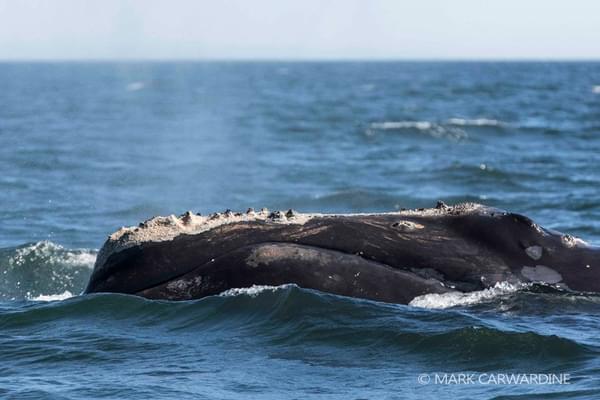ORCA Ocean Conservationists onboard a cruise ship off of the coast of Canada have had two encounters with one of the most endangered whale species on earth - the North Atlantic right whale.
Whilst sailing in the Gulf of St. Lawrence, the ORCA team onboard the Fred. Olsen Cruise Lines’ Borealis were lucky enough to spot three North Atlantic right whales in two separate encounters.
One of the animals was even able to be individually identified by experts at Canada’s Department of Fisheries and Oceans. By studying the callosities on their heads and other markings on the body, it was confirmed that the sighting was of EGNo#1507, a 39-year-old male whale known as Manta.
In an email to ORCA confirming the identification, the department expert said:
“Prior to your sighting, the last confirmed reported sighting [of Manta] was on Sept 18, 2024, reported by the Mingan Island Cetacean Study group from one of their boats, in a position not far from where you saw him. He’s one of my favourite whales and a frequent visitor to the Gulf of St. Lawrence, with numerous sightings here since 2018.”

The North Atlantic right whale is a species that was decimated by industrialised whaling, but since the ban on hunting the species in 1935, population recovery has been slow and the remaining ~370 animals find themselves under threat by new issues such as vessel strike and entanglement in fishing gear.
Sally Hamilton, CEO of ORCA said:
“The two sightings mean that ORCA have now encountered North Atlantic right whales four times, with the last being a sighting of North Atlantic right whale #4191 almost exactly a year ago in the Bay of Fundy.
The surveys we undertake from our cruise ship partnerships create the possibility of more sightings and data collection about these magnificent and highly-endangered animals.”
James Moss, Cruise Product Manager at Fred. Olsen Cruise Lines, said:
“Our guests were fortunate to have enjoyed two rare encounters with North Atlantic right whales with the ORCA team on board Borealis while sailing through the Gulf of St Lawrence, Canada.
“We know that our guests are nature lovers, so spotting native wildlife while on board our smaller-sized ships is something that they truly cherish, especially when rare sightings like these are made.
“We’re so proud of our working relationship with ORCA to learn more about the wildlife sighted from our ships, while playing a part in capturing key data for ORCA’s Cruise Conservationist programme.”

The account from the ORCA team onboard sheds more light on the very special day they enjoyed:
We proceeded to sail around the north side of Anticosti Island in the Gulf of St. Lawrence on our way to Corner Brook, Newfoundland. Chris saw what he thought was the first North Atlantic right whale as he walked over to the starboard side of the ship, having just had a view of a v-shaped blow on the port side. The whale was around 270m away which allowed for some excellent viewing and photo opportunities for us, and for guests, as it travelled past us parallel to the ship.
We could clearly see the broad back and lack of dorsal fin and immediately thought it could be a North Atlantic right whale. Then, when it surfaced again, we could see the diagnostic white callosities callosities (rough, calcified skin patches which only appear on right whales) on its head, and the all-important v-shaped blow. The animal then fluked as it went down the port side, showing its dark tail fin with smooth edges.
About an hour later, we were lucky enough to see two more North Atlantic right whales! This time, two whales were seen much further away, closer to the horizon. However, we were able to watch them for some time. They rolled as we sometimes saw their pectoral fin poking out the water and fluked.”
Vessels are required to report North Atlantic right whale sightings to the Department of Fisheries and Oceans.
Since there are such a small number of individual North Atlantic right whales left, huge efforts have been undertaken by US and Canadian marine authorities to better protect and understand this enigmatic species. Vessel strike, along with bycatch, are the two main threats impacting this species.
A network of voluntary, mandatory and dynamic speed restricted zones and vessel traffic management measures are established in the Gulf of St Lawrence every year between April to November, when the whales are visiting to feed. Some of these measures are triggered only when a sighting is reported, making monitoring the species even more important.
Borealis was sailing in the ‘North Static Zone’, where larger vessels are required to travel at a maximum speed of 10 knots, and at the time of the sighting, the Captain was travelling below this speed. Speed restrictions greatly reduce the risk of vessel strike, as well as reducing the likelihood of a collision being fatal.
These sightings were immediately added to WhaleInsight, an interactive map of North Atlantic right whales, which generates management measures and grid closures (fishing closures). This critically important information manages risks to this highly endangered species, and once again highlights how important reporting these sightings are.

ORCA's work to protect whales and dolphins has never been more important and to help safeguard these amazing animals for the future we need your help. Please support our work by donating at www.orca.org.uk/donate to help us create oceans alive with whales and dolphins

